Friday, July 31, 2009
Finding "Doucement" in America
Today I left France. For travelers, the hard part about coming home (aside from the depressing “mundacity” of unpacking) is deciding what all of this life upheaval means. Some of the answers are so obvious. New friendships are the best souvenirs to bring home. I discovered that a cheese board and a loaf of bread did more to cultivate friendships than a common language. No “French for Travelers” book included the phrase that started conversations flowing faster than anything – “Do you have pictures of your grandchildren?” You always have so much more in common with the people who populate the landscapes you explore than you have differences. In a village so small it has no street names you can spend an evening sharing a love of needlework and the children from Russia and Belarus we’ve each brought into our families.
Travel also helps you identify your limits and why you’re glad to return home. The entire country of France could be a UNESCO World Heritage Site for its efforts to preserve their whole history and culture. However, for reasons I’ll never understand they are satisfied to have toilets in public places that could have been designed in the Paleolithic age. The same way that I think all Americans should spend a week riding the local, express, and high-speed trains and metro systems of France to understand the bliss of well-funded public transportation, I think all French should spend a week just visiting public toilets in every restaurant, shopping mall, service station, and rest stop in my country. I’m sure that any culture that can design and manufacture an engineering wonder like the TGV train or a train to travel under the English Channel can come up with a better restaurant bathroom than a unisex one in which you are greeted by a urinal right inside the door (is that the restaurant floor show every time the door opens?) and two toilet stalls without actual toilet seats. At least I was spared from ever opening the door and experiencing my own private viewing.
I know that one element of French culture I would like to understand better and perhaps even have transform me can be summed up in the word doucement. In my Oxford French Mini Dictionary the word is defined as “gently, quietly, slowly.” It seems so much more, though. As I wove my way through crowded sidewalks I heard it. I heard it directed at dogs more eager to play than walk on the leash. A brief, murmured repetition of the word, perhaps with a slight touch on the arm or finger to the lip for emphasis. I heard it almost every day directed toward children in restaurants, on airplanes, on buses and the street. This is what made it seem so much more than a simple parental command. During all my visits to France many words and phrases have popped up on a regular basis – voilá, comme ça, la ba and more. All were familiar from Berlitz language lesson CDs. All had such distinct uses. Doucement was a word I had no inkling existed, yet I couldn’t escape it in any corner of that country.
To have old and young reminding each other so often “gently, quietly, slowly” imparts a cultural norm rather than makes a request. And I saw it practiced everywhere I went. Rarely did I hear a raised voice. No one sat at a restaurant making sure that everyone overheard a phone conversation about what a jerk his boss was. It would take fewer than my ten available fingers to count the number of times I heard a cell phone ring, even in a town as huge and bustling as Paris. Bus rides (even at rush hour) were relaxing for it. I want to live in a world moving at the speed of café life, where there is always time in the afternoon to eat an ice cream cone and window shop for a bit. I want to reduce the stress so that being gentle with one another requires so much less effort. It requires strolling through streets with an armload of sunflowers. It means taking breaks that shift the course of a day or a mood. I want to start my morning a little later because today is market day and the local strawberries are in season. One must have priorities, you know.
I can’t bring all of France here to the States. Nor would I necessarily want to. They seem to have an inexplicable belief that each individual is exempt from random laws of government or courtesy – where they drive their motor scooters, where they let dogs do their business and whether they clean up, smoking . They are oblivious to the benefits of standing in a line. None of their shoes fit wide feet. But they have internalized how to live in a world steeped in doucement. The trick for this returning traveler to find the adapter that lets me plug it in to an American world operating on its own extreme high voltage. Perhaps I’ll take up yoga and make “gently, quietly, slowly” my mantra.
Say it to yourself several times. Doucement . . . doucement . . . doucement. It slides over the tongue. The hard “t” at the end is swallowed in that very French way, so that it is almost all lips, no teeth, in its pronunciation. The word is as soft as its meaning. If you want to know what France is like, but don’t have time or money right now to explore it own your own, just say the word and practice a life lived gently, quietly, slowly. It’s possible to have that world over here.
Labels:
Dijon,
doucement,
France,
Julie Farrar,
language,
Place de la Liberatíon,
travel
Thursday, July 23, 2009
Seeing Paris on My Dime
“La droit, la droit! Splish splosh, splish splosh! Derrière, derrière!” It was one o’clock in the morning and my French friends had been taking me on a nighttime tour of the City of Lights. We had just spent an awe-inspiring time on the lawn of the Eiffel Tower taking photographs of the engineering marvel lit up and glowing golden against the night sky. I thought the show was over as we drove past the Grand Palais on our way back to Montmartre when four people started gesticulating and telling me in French with no little urgency, “Look to the right, the right! Behind you, behind!” I was turning every which way in the front seat trying to figure out what the excitement was about. All I could see on my right were the trees that lined the quai along the Seine. But when Christophe sped up and made a quick turn onto Pont Alexander III I saw it. The Eiffel Tower, which only a few minutes ago had shown like a giant flame in the night, was exploding white and blue, like fireworks. It kept flashing with abandon (Martine’s splish splosh), as if someone had plugged an electrical cord into a wet outlet. The car went silent as we reveled in the spectacle. Then just seconds later someone flipped a switch and the structure that dominates the Paris skyline just disappeared into the darkness, as if it never existed.
So ended my whirlwind trip to Paris.
It was only my third visit to the city. Each time has only been briefly. There is too much to see and do, so learning Paris’ neighborhoods one arrondisement at a time means that it will take a lifetime to know the place (I’m willing to put forth the effort). However, Martine and I did our best to cover as much ground as possible during the day, while Christophe (with help from friends Jean-Claude and Raymonde) helped entertain me at night. I won’t give a blow-by-blow account of this journey. Instead, here is a quick run down of things I love and hate about the city.
Things I Love
1) The warmth and hospitality of people like Martine and Christophe, and Jean-Claude and Raymonde (and their dog LuLut), many of the shopkeepers (especially at The Red Wheelbarrow bookstore), and strangers on the streets.

LuLut
2) The perfect serenity of Musée de l’Orangerie, where you will escape into the soft focus of Monet’s Le Nymphéas (The Water Lilies). The interior space was constructed specifically to house these large and extraordinary paintings, and to allow visitors to sit, and stare, and soak it all in under the canopy that filters the natural light. For those who will never get to Paris, click here and take the virtual tour at the museum’s website. You can also view an extensive collection of Cézanne, Renoir, early Picasso, and other artists near the turn of the century.
3) The extensive metro/bus system (and beyond, the national train system that got me there quickly and in comfort) that allows you to traverse this immense city cheaply and quickly. It remains a mystery to me why my own country still insists on maintaining its love affair with the car.
4) The Paris parks, big and small. In particular, everyone must visit Les Tuileries, the Jardin du Luxembourg, and Place des Voges (the oldest planned square in Paris). In a city with so much traffic and so many people on the move on narrow sidewalks and metro cars, it soothes the soul to take a rest in the green garden chairs at any of the many parks and squares in this city.
5) Walking through the metro tunnels, hearing a violinist (but not seeing her in the underground labyrinth) playing a Georg Telemann piece as you exit the train then returning in an hour or so and hearing her playing Samuel Barber. I loved hearing flamingo guitar on the streets of Montmarte, klezmar music as I exited the metro in the Marais, and a gypsy violin as I walked the morning streets to the train.
6) The beauty of the architecture that is clearly valued by the residents of this city. Martine and Christophe may live in a small space at the foot of Montmarte, but they know the history of their renovated Art Deco-era apartment building. The city knows that they are custodians of historical treasures, so they find the way to make the old and new work together.
7) Montmartre at night looking like something out of a Van Gogh painting. The warm glow of the café lights under the low awnings, the artists walking the streets with easels packed under their arms, the waitress with her hair wrapped in a scarf and leaning against the wall outside the door of a restaurant kitchen with the glow of sweat on her face as she stares into spacing smoking a cigarette are all images we’ve seen before on canvas from another age.
Things I Could Live Without
1) The traffic. It is absolutely terrifying. I don’t know if there are any driving rules. I do know that on many major streets there don’t seem to be any lanes marked, and I never saw a speed limit sign, and tailgating at a hair’s breadth distance is a national pasttime. So I let out audible gasps as Christophe expertly wove his way through the streets, squeezing in between cars, avoiding the motorcycles buzzing through any free space between cars, and making all the correct turns when there didn’t seem to be any visible intersection or street signs.
2) The desk clerk at my hotel who decided I needed to be schooled in the pronunciation of my room number “45” at 11:30 at night when all I really wanted was my key and bed.
3) The exhaustion (and sore feet) that come with trying to navigate so much of the city in a day. I’d love a longer and more leisurely visit some day.
4) Shops that close on Mondays. It seemed the ones we wanted most, like the small grocer (Thanksgiving) that specializes in American food products that Martine wanted to see, were closed. The French take their leisure seriously, and for that I admire them. A day off is really a day off to relax with friends and family. However, Monday was the only day I could be there. I guess that means I have to arrange another visit – however, it will include different days of the week.
So ended my whirlwind trip to Paris.
It was only my third visit to the city. Each time has only been briefly. There is too much to see and do, so learning Paris’ neighborhoods one arrondisement at a time means that it will take a lifetime to know the place (I’m willing to put forth the effort). However, Martine and I did our best to cover as much ground as possible during the day, while Christophe (with help from friends Jean-Claude and Raymonde) helped entertain me at night. I won’t give a blow-by-blow account of this journey. Instead, here is a quick run down of things I love and hate about the city.
Things I Love
1) The warmth and hospitality of people like Martine and Christophe, and Jean-Claude and Raymonde (and their dog LuLut), many of the shopkeepers (especially at The Red Wheelbarrow bookstore), and strangers on the streets.

LuLut
2) The perfect serenity of Musée de l’Orangerie, where you will escape into the soft focus of Monet’s Le Nymphéas (The Water Lilies). The interior space was constructed specifically to house these large and extraordinary paintings, and to allow visitors to sit, and stare, and soak it all in under the canopy that filters the natural light. For those who will never get to Paris, click here and take the virtual tour at the museum’s website. You can also view an extensive collection of Cézanne, Renoir, early Picasso, and other artists near the turn of the century.
3) The extensive metro/bus system (and beyond, the national train system that got me there quickly and in comfort) that allows you to traverse this immense city cheaply and quickly. It remains a mystery to me why my own country still insists on maintaining its love affair with the car.
4) The Paris parks, big and small. In particular, everyone must visit Les Tuileries, the Jardin du Luxembourg, and Place des Voges (the oldest planned square in Paris). In a city with so much traffic and so many people on the move on narrow sidewalks and metro cars, it soothes the soul to take a rest in the green garden chairs at any of the many parks and squares in this city.
5) Walking through the metro tunnels, hearing a violinist (but not seeing her in the underground labyrinth) playing a Georg Telemann piece as you exit the train then returning in an hour or so and hearing her playing Samuel Barber. I loved hearing flamingo guitar on the streets of Montmarte, klezmar music as I exited the metro in the Marais, and a gypsy violin as I walked the morning streets to the train.
6) The beauty of the architecture that is clearly valued by the residents of this city. Martine and Christophe may live in a small space at the foot of Montmarte, but they know the history of their renovated Art Deco-era apartment building. The city knows that they are custodians of historical treasures, so they find the way to make the old and new work together.
7) Montmartre at night looking like something out of a Van Gogh painting. The warm glow of the café lights under the low awnings, the artists walking the streets with easels packed under their arms, the waitress with her hair wrapped in a scarf and leaning against the wall outside the door of a restaurant kitchen with the glow of sweat on her face as she stares into spacing smoking a cigarette are all images we’ve seen before on canvas from another age.
Things I Could Live Without
1) The traffic. It is absolutely terrifying. I don’t know if there are any driving rules. I do know that on many major streets there don’t seem to be any lanes marked, and I never saw a speed limit sign, and tailgating at a hair’s breadth distance is a national pasttime. So I let out audible gasps as Christophe expertly wove his way through the streets, squeezing in between cars, avoiding the motorcycles buzzing through any free space between cars, and making all the correct turns when there didn’t seem to be any visible intersection or street signs.
2) The desk clerk at my hotel who decided I needed to be schooled in the pronunciation of my room number “45” at 11:30 at night when all I really wanted was my key and bed.
3) The exhaustion (and sore feet) that come with trying to navigate so much of the city in a day. I’d love a longer and more leisurely visit some day.
4) Shops that close on Mondays. It seemed the ones we wanted most, like the small grocer (Thanksgiving) that specializes in American food products that Martine wanted to see, were closed. The French take their leisure seriously, and for that I admire them. A day off is really a day off to relax with friends and family. However, Monday was the only day I could be there. I guess that means I have to arrange another visit – however, it will include different days of the week.
Saturday, July 18, 2009
Along the Burgundy Canal
The best way to experience the Burgundy region is to get out of the city and into the country. Cities like Dijon and Beaune offer so much in terms of food, shopping, and culture, but the smaller villages entice the traveler as well. In the United States if you got off the main highways and took the backroads, there would be a lot of uncertainty as to when you hit a town of any size and if you’d find anything to make you hit the brakes and explore. America has so many small town treasures, but finding them takes real effort and research or a touch of luck.
In the Burgundy region of France, however, enchanting historical villages are strung out along the roads like pearls on a necklace. You rarely go more than 5 kilometers before seeing a sign with an arrow pointing to another one just around the bend. Each one makes you want to stop and spend a few hours relishing the gardens or the history or lunch while watching the local traffic, which is frequently measured in bicycles or pedestrians.
The two unifying features of the Burgundy landscape are the vineyards and the canals. When Brad and I were in Dijon during the fall of 2007 our landlord, Max Renau chauffeured us through a tour of all the best chateaus and cellars in the region (click here to see all the fine accommodations and services Max and his wife, Beatrice, offer their renters). For this visit, he provided bicycle rental and transport 50 kilometers (about 30 miles) outside of Dijon to his home in Chateuneuf-en-Auxois so that we spend all day riding along the flat canal towpath back to our home base, the Port-du-Canal in Dijon.
The Burgundy canal is a 240-kilometer engineering feat that connected the north and south of France because no rivers ran in that direction. It allowed commerce and industry to grow in the area between the Yonne and Saône rivers. Now it services luxury and vacation barges, the Burgundian version of fifth-wheeler campers and custom RV’s.
Before pedaling a single kilometer, I promised Brad that I wouldn’t stop to photograph every bird, wildflower, or stone cottage I saw for fear that we wouldn’t reach home until long after the sun set. So this ride became a true test of will. I won’t even begin to tell about the fields of sunflowers turned toward the light, the giant wild butterfly bushes with deep Concord grape arms bowing under the weight of butterflies, and saucer-sized Queen Anne’s lace.
What really challenged the photographer in me, however, was not stopping to photograph every écluse, or lock house, that still operates along the canal. Appearing every couple of kilometers, many are still occupied. Canal service workers race up and down the towpaths on scooters tending to many of the lock operations, but often it’s a hand-operated system worked by the lock house resident or the barge residents. These stone houses with their geraniums and rose bushes and white bed sheets waving on the line at the water’s edge made me want to park my bike and start a new life that day.
Écluses (lock houses) along the canal
We rode past such charming towns as Pont-d’Ouche (the canal paralleled the Ouche River), Veuvey-sur-Ouche, and La Bussiére-sur-Ouche. Our greatest find, however, was to stumble upon an outdoor restaurant at Écluse de la Charme. But outdoor, I mean the restaurant was in one tent and the kitchen was in another. But despite the rustic atmosphere, I ate duck with mushrooms and Brad could order a bottle of wine. The lock house had a gallery of photographs showing all the wildlife in the immediate area and sold regional products such as honey.While there, we had the great fortune of watching a boat go through the lock. It was all automated and with the push of a button the process began. The boat was through the lock and on it’s way in about 15 minutes. After a lunch of good food and good conversation with a couple who lived down the road in Saint Victor-sur-Ouche (who so kindly waved to us when we passed their home later) and the young man who served us and spoke perfect English since his mother was from Birmingham, England, we were on our way as well with only one big detour at Lac Kir to watch a bit of the kayak races.
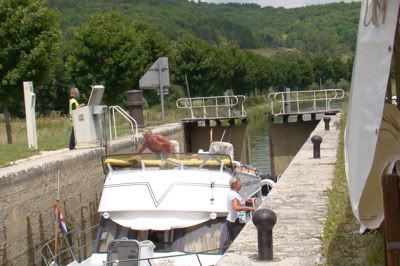
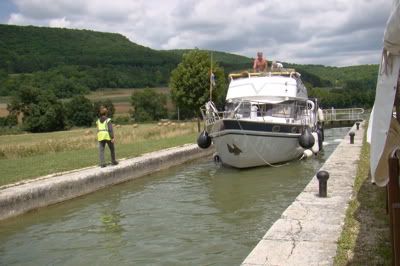
In France, life does not focus only on the largest metropolitan areas. In fact, the second largest city in France – Lyon – has only about two million people. That’s the same size as my hometown of St. Louis, MO – and to many in America a town of two million isn’t even worth visiting. No, France relishes these villages and the land that surrounds them. I lost track soon into our ride the number of people I nodded to and “bonjoured” as I pedaled. The canal was as packed with boats as the path was with bikes. Some were out for a day trip while others on land and water were clearly going the distance.
If I had my way, I’d do the whole trip all over again, only I’d take a week so I really could stop and photograph every flower and écluse, have tea at every village café, and enjoy the land while moving at the same slow pace as the water in the canal I ride beside.
Do you like traveling the back roads? Tell us about your favorite lazy trip in the comments box.
Labels:
Burgundy canal,
dijon-rent-a-home,
écluse,
Julie Farrar,
Ouche river,
Pont-d'Ouche
Friday, July 17, 2009
One Must Agitate
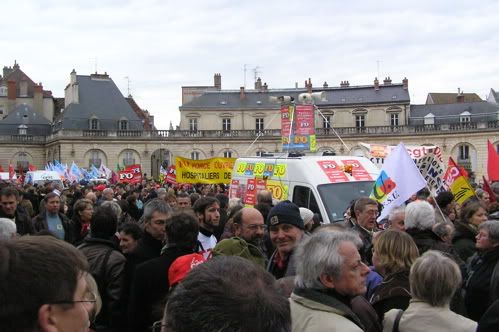
The beginning of a strike march in Dijon's Place de la Liberatíon during the national train strike in November 2007
Some things are universal. No matter what city I’m in or in what country, I’ll inevitably end up in line behind someone who has to make the simple complicated. Whether in a French or an American “McDo’s,” fate will place me behind the one person in the country who walked into that oh-so-familiar fast food establishment actually not knowing what he or she wanted to order. Standing slack-jawed before “le menu”, this novice to ordering a McDonald’s meal engages in deep self-reflection over the choice between a “Royal avec Cheese” or McNuggets. Conversations with the cashier are necessary to ascertain the exact size of the soda that comes with a meal and what the options for sides are – frites? salade? un autre? Of course, this patron of fine dining waits until the last possible moment to reach for the wallet and then decides that today is the day to pay for everything with exact change, even though that requires a search in six different pockets.
Today I walked into a Dijon post office and briefly thought I was back home. It was a small office with only two clerks. It just so happened that at the exact moment I had decided to buys stamps for my postcards two men who had never mailed anything in their entire lives arrived, one at each window. My luck is the same, no matter where I am. Over the years I’ve mailed packages large and small – domestic and oversees, I’ve sent things overnight delivery, I’ve had “return receipt” to verify delivery. I’ve even sought refunds for packages that didn’t arrive when scheduled and had clerks search back rooms for packages that were supposed to be waiting for me but seemed to have disappeared. Yet I’ve never spent more than two minutes getting anything mailed. Most of my conversations with clerks beyond the weather were asking which form I should fill out or what pretty stamps they had in stock for Christmas cards. Yet if there is anybody who wants to complicate the process, you can bet I’ll be in line behind him or her.
My limited French made me ignorant of what the hold up was about. I couldn’t understand their difficulty with filling out a form, but I could understand the wonderful patience of the clerks who listened while each of these men went on at length about whatever grievance they had with the post office and how business was conducted. Arms were waved and voices were raised (not in anger but for emphasis) as each of these customers found further issues with the simple act of filling out a form to attach to their package. One of the fellows even asked to borrow the clerk’s phone so that he could call someone. While he had exerted extreme effort badgering the young clerk just trying to do her duty, he had not exerted any effort in bringing with him the address to which his package was to be sent. I had never witnessed such a grand debate over such an undemanding task as posting mail.
While I watched the ten-minute post office drama in two acts, I remembered a conversation with my husband’s mathematics colleague at Université de Bourgogne. The last time we were in Dijon a national strike occurred across the length of our visit. The main strike was a fight for certain retirement benefits. Many other “sympathy strikes” arose to show solidarity with the cause. It was clear that these work stoppages were not going to be effective, and after the first week even the general populace had given up support as they found it harder to manage transportation to work or day care for children locked out of schools. I asked our friend, Didier, why they continued the strike if it was clear that nothing would change. He told me, “It’s simple – in France, we must agitate!”
So while I didn’t comprehend the words of these two postal protesters, I could hear in their arguments the echo of Descartes and Rousseau, Pascal and Sartre – great agitators all. I just wished that I hadn’t been in line behind them today.
Labels:
Dijon,
French train strikes,
Julie Farrar,
post office
Tuesday, July 14, 2009
Happy Bastille Day!
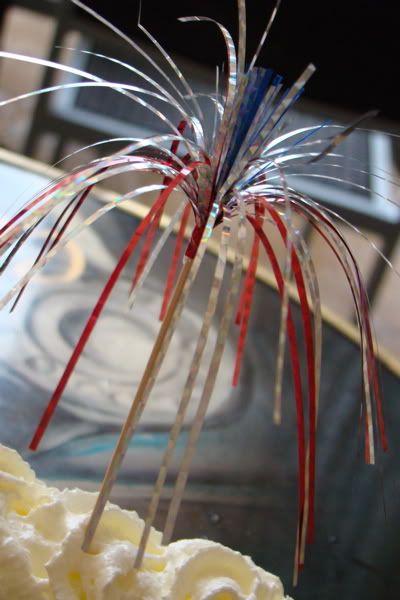
Today is Le Fête National in France. Not too much celebrating going on, however, since it's been raining all day. In fact, it's rained almost every day that we've been here, sometimes buckets like today and sometimes just a steady drizzle. On Monday evening I wanted to get out to get some evening air so I went to my Les Grands Ducs café to get a salad for dinner. Shortly after I grabbed a table under the awning near the front entrance the rain came pouring down. It was blowing inward so the awning was only the most minimal protection. When some people finished and left, I picked up my food, camera, book, and newspaper and moved away from the edge and closer to the center. The rain came even harder. I didn't get the blowing rain too much, but there was a steady drip . . . drip into the center of my plate and in my glass of coke through a leak in the awning. This is what I saw as I ate:
You make ask, "Why, in heavens name, did you continue to sit out on the sidewalk instead of retreating into the restaurant?" Well, first, I was not the only one sitting outside eating. The rain was a minor inconvenience because the French rarely give up an opportunity to dine al fresco. The astounding French waiters never stopped serving, even though most of the tables are out the door and around the corner of the building in the large Place de la Liberátion. They just took an empty tray and held it over their head as they hustled food and drinks out to the people sitting under mammoth sidewalk umbrellas. Second, by the time my dessert arrived, I had moved to a perfectly dry spot in a corner up against the building. I went to that café specifically to eat on Monday so that I could get a Bastille Day ice cream dessert. This particular café always finds some way to dress up the most simple bowl of delicious, freshly made ice cream. Here's my banana split:
Sunday, July 12, 2009
Eat Your Vegetables
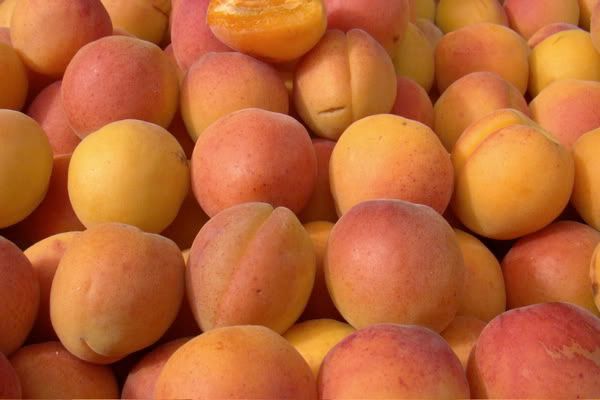
When I’m in France I’m torn between going out to eat for every lunch and dinner (there is no such thing as an IHop for breakfast – the French don’t do breakfast) and staying at home to cook. “Why would you want to cook on a vacation?” you might ask. After all, it means schlepping to the store, the heat of the kitchen, washing dishes, and all those unpleasant tasks that have nothing to do with actually cooking. The reason is quite simple – the street marché. France has modern grocery stores like the Monoprix, or the MarchéPlus, or the Carrefour – bigger than any Super Walmart I’ve been in – but for many the street market is where French cooking begins. It occurs on set days 52 weeks a year, from small villages and on up to giant Paris. In Dijon it’s in Les Halles (a 19th century structure designed by Gustav Eiffel) on Tuesday, Friday, and Saturday mornings.
Yes, the markets will have some out-of-season food shipped in from Spain or Chile or elsewhere, but French food markets are all about regional products, in season. And you know it’s regional because they always tell you the origin of the food, and frequently the name and address of the grower. Food is personal here. You talk to the stall vendors. You have conversations about why you are buying the fruits and vegetables and when you plan to eat it. And the stall vendor frequently picks the fruit for you. There’s no squeezing the tomatoes. But then there is no need to because these haven’t been picked two or more weeks ago, left sitting in a warehouse, and then shipped green and hard. They are picked a day or two before they show up at the market.
The conversations about the food are where you develop a relationship with the vendor. When we were here for an autumn visit I wanted apples for a tart. My vendor wanted to know when I planned to make it so she knew how many days the apples would sit around. She asked what kind of tart I was making. She wanted to know how sweet I liked my apples and how big the tart would be. Then she picked me the fruit that would make my pastry absolutely perfect. When Brad wanted an avocado last week, the vendor first needed to know when he would eat it. Then he gently squeezed a few until he found the perfect one.
Summer is apricot season. The colors are so trés belle that I want to pull out a canvas and paints in order to preserve the shades of colors as well as the textures. The best I can do is aim my camera and hope for the best. Yesterday I fell in love with a display of apricots. As an indirect “payment” to the vendors for letting me photograph their beautiful fruit I asked to buy one apricot. The husband and wife chose a beautiful piece of fruit for me and with a grand sweeping gesture passed it over the display, saying “un cadeau” (a gift). I took the apricot and my photograph then walked home through the teeming food market relishing the slight give in each bite of the fruit’s velvety skin and the sweet juice that ran down my throat. I relished, as well, the opportunity the market gives me to make food personal again.
Yes, the markets will have some out-of-season food shipped in from Spain or Chile or elsewhere, but French food markets are all about regional products, in season. And you know it’s regional because they always tell you the origin of the food, and frequently the name and address of the grower. Food is personal here. You talk to the stall vendors. You have conversations about why you are buying the fruits and vegetables and when you plan to eat it. And the stall vendor frequently picks the fruit for you. There’s no squeezing the tomatoes. But then there is no need to because these haven’t been picked two or more weeks ago, left sitting in a warehouse, and then shipped green and hard. They are picked a day or two before they show up at the market.
The conversations about the food are where you develop a relationship with the vendor. When we were here for an autumn visit I wanted apples for a tart. My vendor wanted to know when I planned to make it so she knew how many days the apples would sit around. She asked what kind of tart I was making. She wanted to know how sweet I liked my apples and how big the tart would be. Then she picked me the fruit that would make my pastry absolutely perfect. When Brad wanted an avocado last week, the vendor first needed to know when he would eat it. Then he gently squeezed a few until he found the perfect one.
Summer is apricot season. The colors are so trés belle that I want to pull out a canvas and paints in order to preserve the shades of colors as well as the textures. The best I can do is aim my camera and hope for the best. Yesterday I fell in love with a display of apricots. As an indirect “payment” to the vendors for letting me photograph their beautiful fruit I asked to buy one apricot. The husband and wife chose a beautiful piece of fruit for me and with a grand sweeping gesture passed it over the display, saying “un cadeau” (a gift). I took the apricot and my photograph then walked home through the teeming food market relishing the slight give in each bite of the fruit’s velvety skin and the sweet juice that ran down my throat. I relished, as well, the opportunity the market gives me to make food personal again.
Labels:
apricots,
cooking,
Dijon market,
France,
Julie Farrar,
rhubarb,
summer
Thursday, July 9, 2009
Strawberry Ode
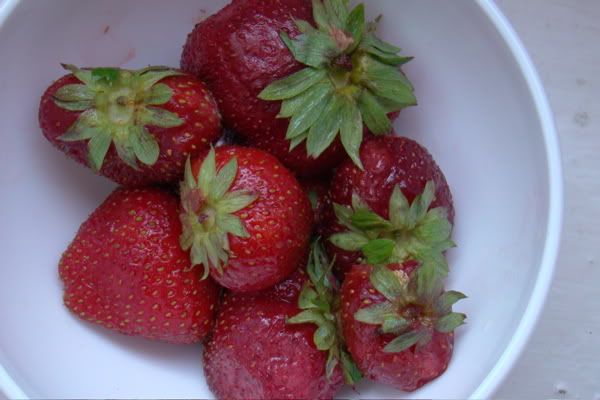
I knew heaven was not far away if I just followed my nose. I was standing at one of the dozens of fruit and vegetable stands that populate Les Halles in the center of Dijon’s Saturday street market. It is next to impossible to do more than creep through at mid-morning on market day because of the SUV-sized baby strollers, the dogs on leashes, and the two-wheeled shopping carts of every description that form a permanent blockade. Brad and I elbow our way to one side of a stand to buy some fruit when our senses are aroused by the strawberries sitting in front of us. I have never been so enticed by a piece of fruit in my life as I wave my hand over the display to bring more of that aroma closer to my nostrils. We buy a carton and I began to dream of breakfast the next morning.
I don’t care how many farmers’ markets you’ve been to in America. And buying from local growers means nothing once you’ve tasted a French strawberry at the peak of perfection. The container filled with these delectables is a work of art. There is none of that dull uniformity of supermarket strawberries on steroids. Americans let themselves be fooled into believing that bigger is better, but beauty comes with a touch of imperfection in the randomness of shapes and sizes in this container. Nature has blessed them all, however, with a bright scarlet that is possible only when the fruit has the opportunity to rest on the vine undisturbed until the exact moment when it is ready to achieve its destiny – my breakfast.
On Sunday morning I slice one in half and find that brilliant red saturating the fruit straight to its heart. Every molecule calls out, “I’m ripe and ready to be eaten.” Soon my fingers and the knife blade drip with the sticky sweetness while the captivating essence of strawberry fills the kitchen. I could eat them straight off the cutting board, but decide to pair them with a serving of French vanilla yogurt. American yogurt would not have the same effect. With a tendency to over-sugar everything, the American counterpart would mask the chance to taste the pure, natural sweetener that is just-picked strawberries.
I scoop up my pieces of fruit and lay them on the mound of creamy yogurt in my bowl. Rivulets of juice make their way down the bone-white dairy folds as the strawberries settle into their soft base. Without delay I push my spoon in and raise an equal amount of yogurt and fruit to my mouth. My tongue slides over the velvet cream and strawberry mélange. If it were ever possible to taste an aroma, this is it. I want to bathe in it and walk through my day covered in a perfume of fresh strawberries. As I sadly reach the bottom of my bowl, my only comfort is that I know I’ll get to do it again tomorrow. And the day after that. And the day after that.
Voilà!
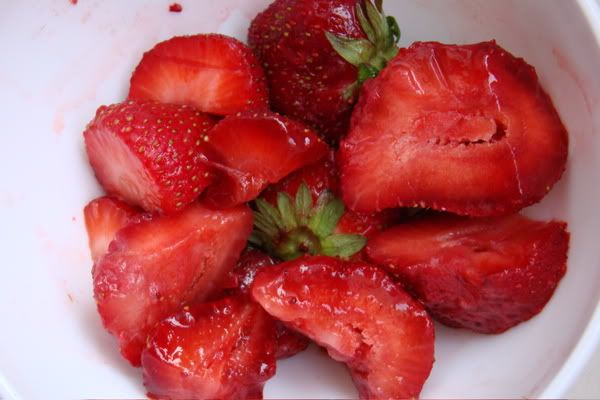
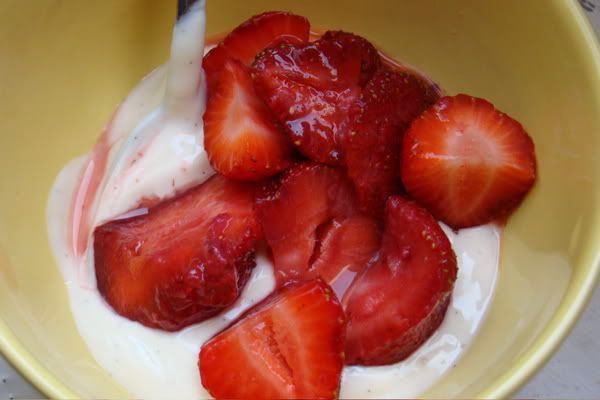
Labels:
France,
Julie Farrar,
strawberries
Sunday, July 5, 2009
Look Up

I love to travel to a place different from where I exist on a regular basis, if only for the fact that it exercises my eyes. At home I’m most often looking to the front, eyes on the road as I drive from place to place, sneaking quick glances to the right or left to check for cars exiting driveways, pedestrians crossing streets, bikes merging into my lanes. Even walking my dogs through my neighborhood my eyes are at street level. I do stop to admire gardens, chat with neighbors, but how I see doesn’t vary much.
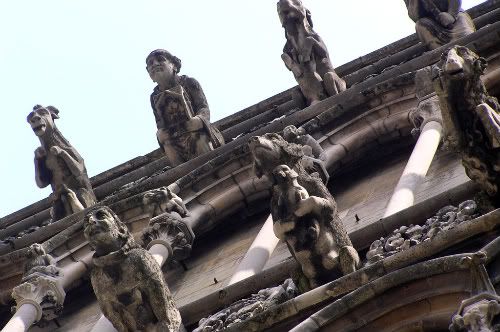
Église de Notre-Dame de Dijon
When in a new place where everything is unfamiliar I find myself engaging in what, for lack of a better description, I might call “spontaneous looking.” I look in new directions and in new ways. My favorite direction to look in French cities is up. This isn’t about the neck-craning wonder of skyscrapers in Chicago or New York. No, in a city like Dijon with its mélange of centuries constructed cheek to jowl, life is frequently happening above street level. It’s summer now, and even if the residents have a climatiseur (those marvelous ductless air-conditioners) when the evening comes they throw open their large windows (what do the call “French doors” in France?) and invite the night air in, perched on their deep window seats or leaning over the wrought iron balcony, watching me watch them.
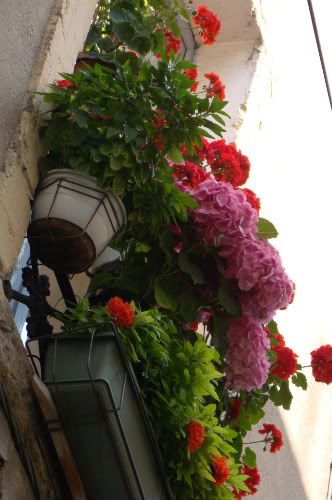
Up is where the French obsession with geraniums takes root. Up is where the lights glow. Up is where the architectural intricacies hide. Up is where unrecognized music drifts out of unknown windows. A suburban American can almost be overcome with vertigo walking down the narrow maze of streets while trying to take in the vista above her. As I write this I sit in my first floor apartment, which in Europe is above street level. My six-foot windows are open to let in the bit of cool air that came with last night’s rain. Rue Hernoux is such a narrow street that I feel I can reach out and touch the half-timbered houses across from me. I stare at a small window, not much more than 12 in. X 18 in. I see a shadow of a head and shoulders but the window stays closed. What room was that when the building was constructed? The window seems too small to be of any use for ventilation. In the neighboring building the current resident sticks his head out of the yellow-glassed windows that encase the ancient, carved wooden staircase to his upper floor (date on a window lintel: 1644) calling down to a friend on the sidewalk.
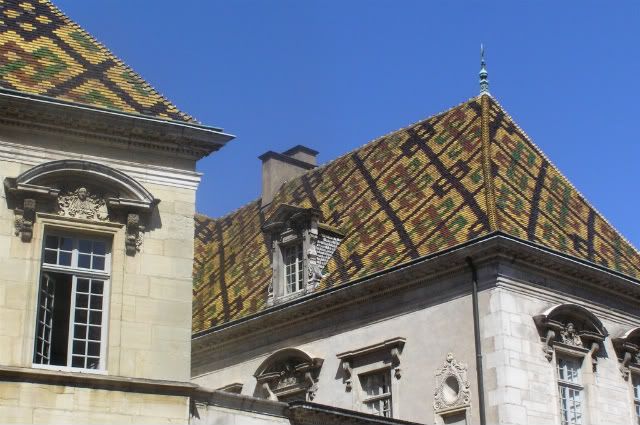
Flemish-influenced tiled roofs found throughout the Burgundy region
So many talk about the café life found in the plazas of major European cities. What they forget to mention is that life is lived vertically as well as horizontally here. The city surrounds me in a way that my own hometown fails to do. Perhaps, however, when I return there at the end of the month I’ll exercise my eyes a little more often and find life happening in a few more unexpected places.
Share your thoughts here
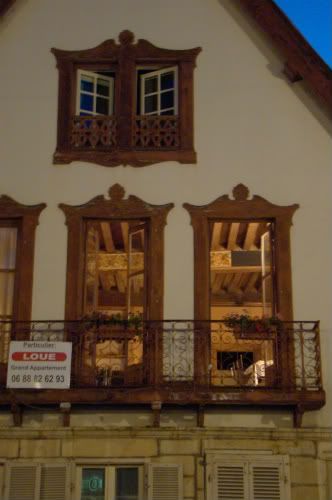
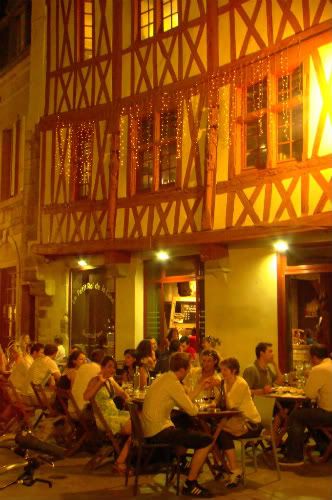
Labels:
Burgundy roofs,
Dijon,
Église de Notre-Dame,
France,
Julie Farrar,
rue Hernoux,
travel
Thursday, July 2, 2009
Un Canard Out of Water

Before boarding a plane for France, I took an overnight road trip to the lovely river town of Moline, IL to meet friends and dance my back end off at a Keith Urban concert. I first spied this serene mama when walking from the parking lot into my hotel. With the “hunting lodge” theme of this hotel I at first thought she was as fake as the carved bear by the front door. Whatever possessed her to make her way up from the Mississippi River, around the end of the conference center, and across the busy parking lot to this planter at the main entrance to set herself up a nursery?
Once when walking past I found her gone, leaving unguarded her half dozen light teal eggs, packed down into the potting soil and surrounded by feather fluff. They looked so vulnerable, exposed as they were to the hustle and bustle of a busy hotel. I guess, though, even a duck mama has to get out of the house sometime and stretch herself a bit. When she picked this spot for her temporary home did she even imagine what it would be like shepherding her brood across the dangerous expanse of blacktop for their introduction to the water? Yet despite the constant activity of her neighborhood, she sat so serenely as car after car pulled up, luggage was transported, and small children threw breadcrumbs at her (which remained uneaten). Here stamina and focus were something quite unfamiliar to me. As I pulled out of the parking lot one last time to head down the highway to home and then board a plane to France, I wondered if she was oblivious to all the challenges of this position in which she had put herself and her family, or if she just had ultimate faith that it would all work out.
So after an interminable plane ride, a 30-minute bus ride into Paris that stretched into almost 2 hours because the driver didn’t seem to know where he was going, and a train delay on the way to Dijon, I hope I can remember this duck who made herself a home in a most foreign place. I want to remain as serene as she amid the challenges and display her calm resolve, having faith that it will all work out as intended.
Labels:
canard,
Dijon,
duck,
France,
Julie Farrar,
Keith Urban,
Moline,
travel
Subscribe to:
Posts (Atom)
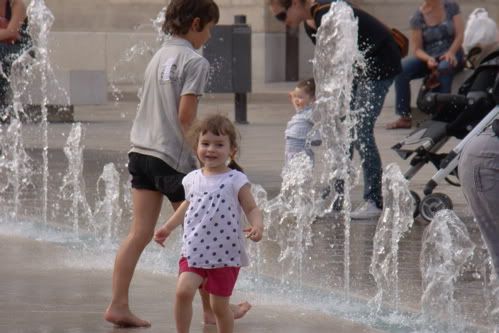
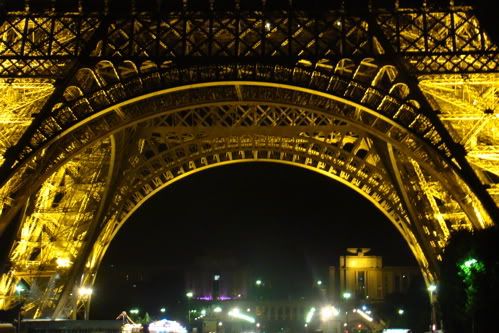
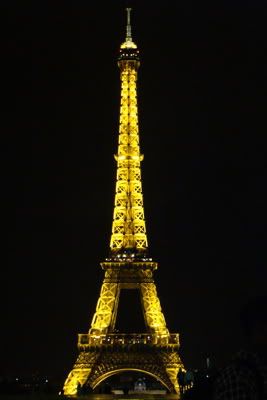
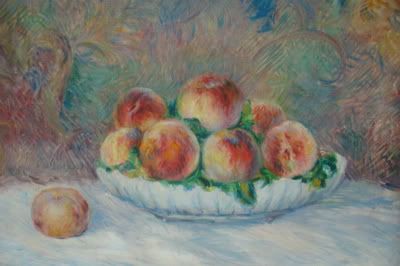
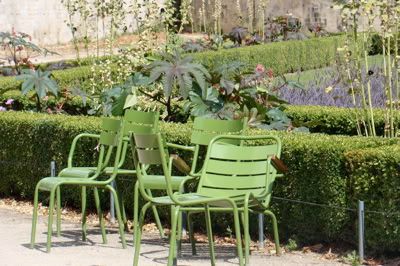
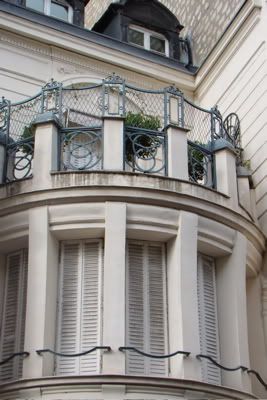
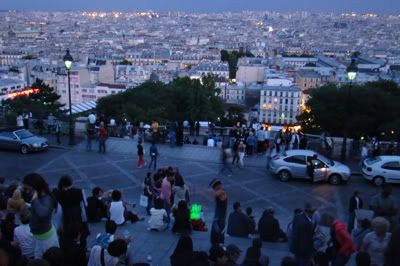
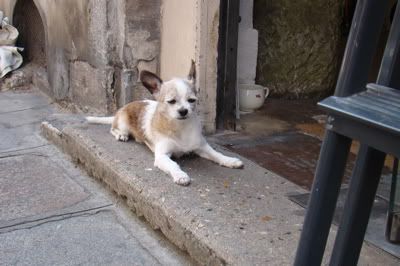
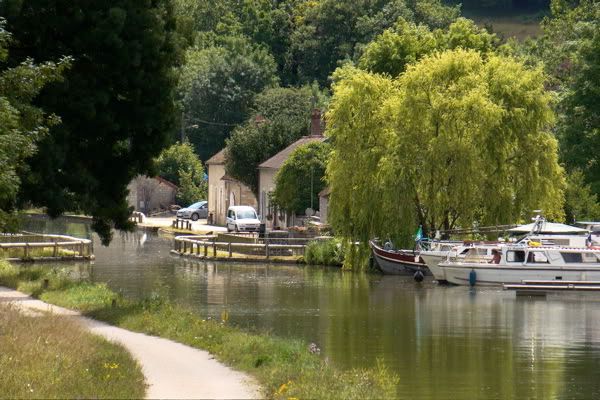
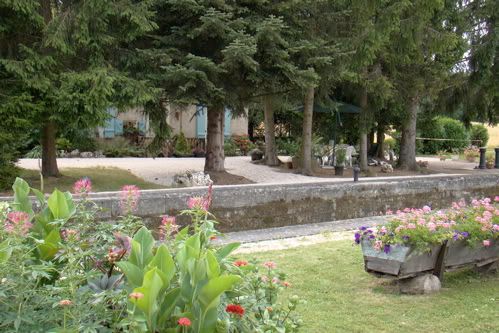
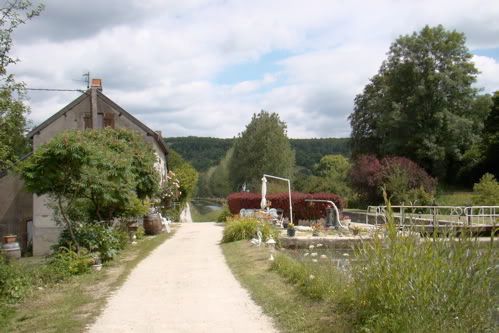
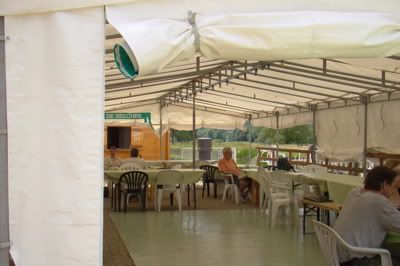
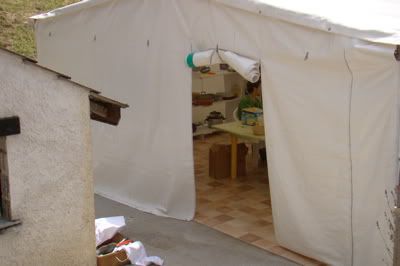
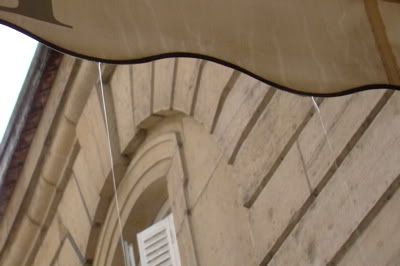
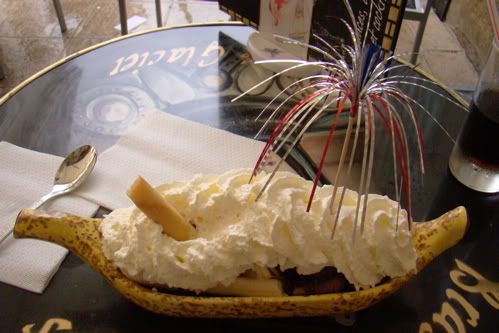
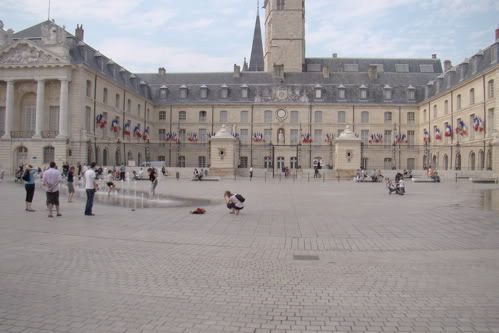
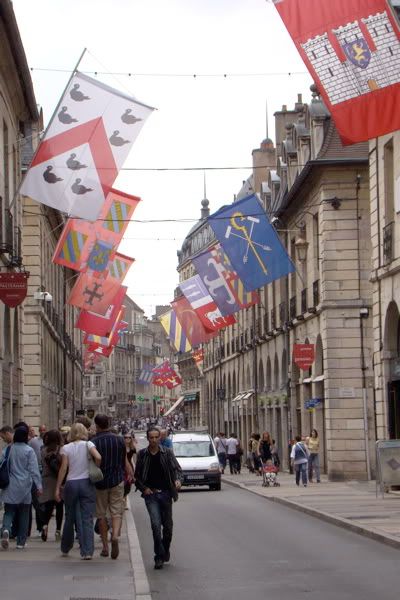
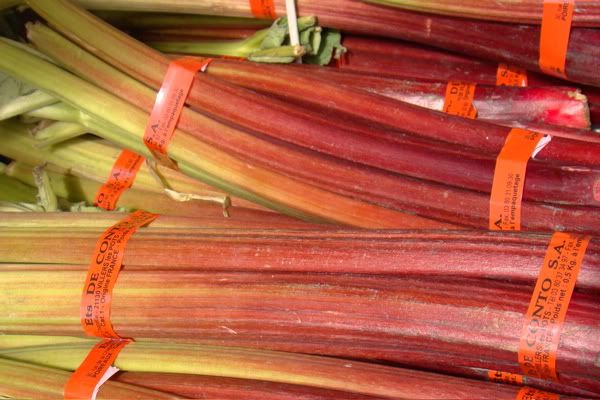
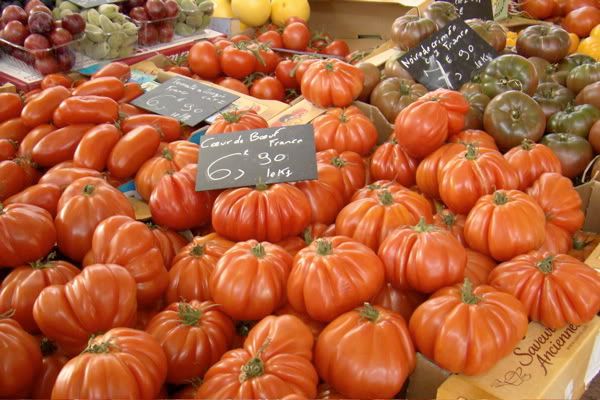
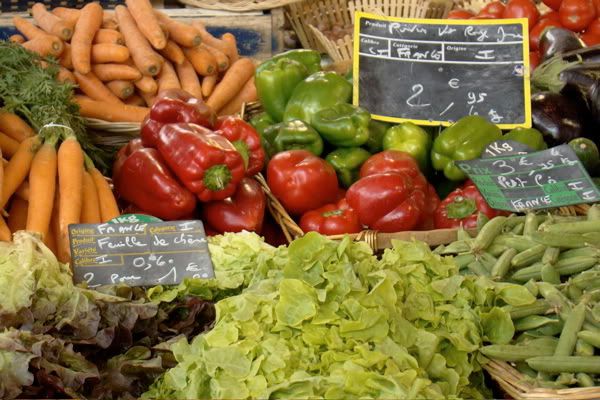
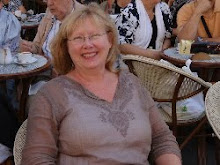



![Grace [Eventually]: Thoughts on Faith](http://photo.goodreads.com/books/1166504427s/12542.jpg)








